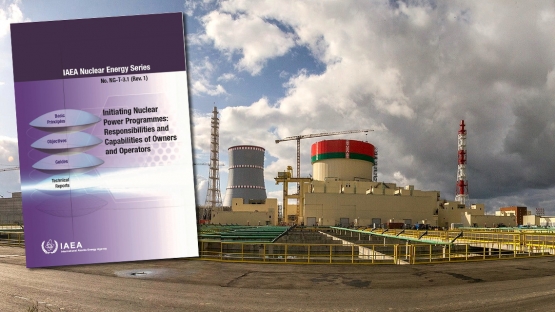
A new IAEA publication provides important guidance to nuclear power newcomer countries in establishing and developing the nuclear power plant’s (NPP) owner/operator, outlining its tasks and responsibilities throughout the phases to prepare for the NPP’s construction and operation.
Initiating Nuclear Power Programmes: Responsibilities and Capabilities of Owners and Operators, published in the IAEA Nuclear Energy Series, No. NG-T-3.1 (Rev.1), offers practical guidance on the main activities, responsibilities and desirable attributes of the owner/operator in a country initiating a nuclear power programme. The publication assumes that the same organization will own and operate the NPP, hence the term ‘owner/operator’. It takes into account over 10 years of experience and good practices in countries that are introducing nuclear power, as well as lessons learned during Integrated Nuclear Infrastructure Review (INIR) missions and IAEA technical assistance activities to newcomer countries.
“The new publication represents a significant revision of a document first issued in 2009,” said Jose Bastos, Technical Lead in the IAEA’s Nuclear Power Infrastructure Development Section. “It provides detailed information on the owner/operator’s activities and responsibilities for each of the 19 infrastructure issues in Phases 2 and 3 of the Milestones Approach. In addition, we have also added detailed references to other relevant IAEA documents, including IAEA Safety Standards.”
All documents can found in the IAEA Nuclear Infrastructure Bibliography.
Together with the nuclear energy implementing organization (NEPIO) and the nuclear regulatory body, the NPP owner/operator is one of the three key organizations identified in the Milestones Approach, the IAEA’s comprehensive framework for developing a nuclear power programme.
After a country decides to launch a nuclear power programme at the end of Phase 1, the owner/operator in Phase 2 needs to conduct a feasibility study, evaluate different technologies and select the preferred ones, prepare a financial plan, and negotiate a contract for the NPP. In Phase 3, the responsibilities of the owner/operator include applying for the required licences, overseeing construction and preparing for operation.
The publication also describes how to establish the owner/operator organization, its organizational structures and role in the nuclear power programme, how to manage its growth as the programme develops and how to acquire the necessary competencies for staff and interact with a wide variety of stakeholders.
“Since the owner/operator has prime responsibility for the safety and security of the NPP, it should develop an organizational culture that promotes the appropriate attributes, values, standards, morals and norms of acceptable behaviour that are necessary at a nuclear facility,” Bastos said.
Strong leadership is important, in addition to the ability to manage growth and change, technical and commercial competence, and clear procedures for internal and external communication. The owner/operator has to engage with stakeholders including national, regional and local authorities, regulatory bodies, the vendor, emergency response and technical support organizations, the grid operator and the public.
The new publication is intended for decision makers, owner/operator executives and staff as well as others in organizations involved in the nuclear power programme. It may also be useful to countries expanding their nuclear power programmes after long periods without new projects.
IAEA Milestones Approach
First issued in 2007 and revised in 2015, the IAEA Milestones Approach supports countries in creating an enabling environment for a successful nuclear power project and to understand, and prepare for, the associated commitments and obligations. This result-oriented approach comprises three phases (consider, prepare, construct), three milestones (decide, contract, commission and operate) and 19 infrastructure issues to be addressed in each phase, such as nuclear safety, nuclear security, safeguards, legal and regulatory frameworks, radioactive waste management, human resource development and stakeholder involvement.
Over the past decade, the Milestones Approach has become a reference for Member States starting or expanding their nuclear power programmes. The Milestones Approach and supporting documents are widely used, and its framework and terminology have been broadly accepted.

